
Anomalies of the occlusion are various deviations from the normal arrangement of the dentition relative to each other. Similar deviations can appear both in adults (for example, after teething wisdom teeth or due to trauma), and in children during the period of growth and formation of the dentition.
The severity of an abnormal bite can vary significantly - depending on the severity of the pathology, I, II and III degrees are distinguished. However, even quite minor malocclusion sometimes create very serious problems for a person’s normal life, starting from psycho-emotional and ending with problems with eating.
Therefore, let’s talk about what kind of malocclusion there are and what treatment methods modern dentistry offers in this or that situation. And, importantly, let's see what preventive measures parents can take to protect their child from bite problems in the future.
What are malocclusions?
Orthodontists use the Engle classification in their practice. He distinguished 3 types of bite, depending on how the first molars (that is, the so-called molars) close together.
Angle's first class is considered the norm of occlusion, a kind of standard that the orthodontist tries to achieve if there are any deviations from the normal ratio of teeth. It was revealed that the closure of teeth in the first class of Engle is the most physiological for the entire dentition of the person.

The second and third classes of Angl malocclusion according to Engle will be discussed in detail below.
On a note
To date, orthodontists classify abnormalities of closure in the lateral part of the teeth as sagittal anomalies, and deviations in the anterior part of the dentition as vertical malocclusions.
Pathology abnormalities include such pathologies when, with normal closure of teeth, the following defects are present in the lateral region:
- The median diastema is the gap between the first incisors of the upper jaw. In an early intermittent bite (from 2.5 to 4.5 years), a diastema is a normal physiological condition when the frenulum of the upper lip passes between temporary central incisors. With normal development during the eruption of lateral incisors and fangs, this gap closes, and the attachment of the frenum is shifted and woven into the mucous membrane of the upper lip. In some cases, the cause of the diastema may be the presence of a supernumerary tooth in the area of the discrepancy of the central teeth of the upper jaw (this pathology can be identified by the results of an X-ray examination).

- Crowding of teeth - this malocclusion occurs when the size of teeth and dental arches do not match. Approximately 60% of children in the European population show some degree of crowding. In such a situation, the loss of a permanent or temporary tooth may cause neighboring teeth to move to the area of the defect in order to fill the void. Crowding of the lower teeth in adolescence is mainly due to teething wisdom and the pressure that they exert on the dentition.

- Three - gaps between the teeth. It is important to understand that in a removable bite, the presence of three is a normal phenomenon, due to the fact that milk teeth diverge and prepare a place for permanent larger teeth. Three can occur with microdentia - the small size of the teeth themselves. In any case, the parents of the child should pay attention to such gaps between the teeth, as they clog the food, which with poor hygiene can lead to caries and gum disease.

- Transposition or dystopia of the teeth - these similar terms refer to teething in a place unusual for him. There are several reasons for this phenomenon. For example, this may be an abnormal position of the tooth germ due to a hereditary factor, abnormalities of the fetus during pregnancy, maternal illness in the first stages of pregnancy, childbirth trauma, forceps during obstetric care, etc. The cause of tooth dystopia may be another - lack of space in the dentition causes them to erupt outside the dental arch: on the cheeks, on the lips, causing injury to the child when chewing and forming a focus of inflammation, because sometimes it is quite difficult to get to such a tooth when brushing.

The following malocclusion anomalies will be considered in more detail.
Distal bite
Distal bite is the most common malocclusion among the European population. Many associate its occurrence with the nature of the food taken - we began to eat more soft food, in connection with which there is no need to chew and apply effort. The lower jaw is reduced in size, is no longer so advanced, and the upper jaw prevails over the lower. Distal bite is an anomaly of class II according to Engle's classification.
The photo shows an example of a distal bite:

In the distal bite, two subclasses are distinguished, depending on the inclination of the maxillary incisors.
Class II, subclass I - upper incisors inclined towards the upper lip. The reasons for the formation of this phenomenon may be the habit of sucking a finger, prolonged sucking of the nipples, the habit of laying the tongue between the teeth, as well as hyperactivity of the muscles of the upper lip and the circular muscle of the mouth.

Facial signs of this type of occlusion are a concave profile, open lips, compensatory extension of the lower lip forward and upward. Sometimes there are cases of excessive activity of the lower lip (for example, with the habit of biting the lower lip), then the upper incisors are advanced, and the lower ones fall backwards from the normal position.
Class II, subclass II - the upper incisors are inclined towards the sky. A provoking factor may be the habit of biting the upper lip, as well as the infantile, that is, the children's type of swallowing with muscle tension in the lips and cheeks. In such cases, upon examination of the patient, the lips are closed, the lower lip is thickened, a deep fold on the chin is highlighted.

A distal bite is often accompanied by a speech disorder, impossibility, or difficulty in biting off food, difficulty breathing, as well as pain and dysfunction in the temporomandibular joint.
Note how the shape of the jaw changes after treatment for a distal bite:

Mesial bite
Compared with the distal bite, the opposite situation is observed with the mesial bite - when the upper jaw is behind in size from the lower jaw. This is the third class of malocclusion according to Engle's classification.
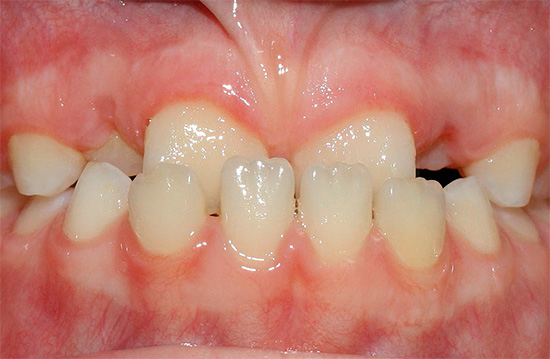
The reasons for the development of the mesial bite can be:
- birth injury;
- early extraction of teeth of the upper jaw;
- genetic predisposition - for example, a child has a massive lower jaw from his father and a small upper jaw from his mother.
Often, with this anomaly of occlusion, you can see a phenomenon such as gingival compensation: the teeth on the upper jaw are crowded, while on the large lower jaw extended forward, they are even, there may be gaps between them (three).
Facial signs of the mesial bite: a convex profile, the chin protruding markedly forward, the retraction of the upper lip and protrusion of the lower lip.

The mesial bite contributes to the development of disorders of the temporomandibular joint - due to the anterior position of the head of the upper jaw in the articular fossa, there is a constant tension of the TMJ, tension of the temporal and chewing muscles, the development of pain during eating, as well as headaches.Sometimes patients complain of trauma to the upper lip with the teeth of the lower jaw during meals.
Open bite
An open bite is a non-closure of the teeth in the anterior region, due to which a gap is formed between them. Normally, the upper incisors should overlap the lower incisors by one third of the crown size. With an open bite, there is no overlap at all, or minimally.

The following types of open bite are distinguished:
- front open bite - there is no overlap in the anterior part of the dentition with closed lateral teeth;
- lateral open bite - when the teeth overlap in the anterior section, the lateral teeth do not close.
Among the causes of this anomaly are described:
- hereditary factor;
- oral breathing - in this case, the child needs a consultation with an ENT doctor, because it is important to understand why the child breathes through the mouth. Perhaps there was an injury and there is a curvature of the nasal septum, or the presence of adenoids. Sometimes weakened immunity and frequent colds can also make it difficult for a child to breathe nasally;
- the habit of sucking a finger, prolonged sucking of nipples and other objects;
- infantile type of swallowing and the habit of laying the tongue between the dentition;
- congenital malformations - cleft alveolar ridge of the lip and palate;
- endocrine disorders;
- tumors of the maxillofacial region.
Facial signs of an open bite: the mouth is half-open, but if it is possible to close the mouth, then the face is tense.

Patients complain of the inability to fully bite off and swallow food, often lisping is observed.
There are 3 degrees of severity of an open bite, depending on the size of the vertical gap: I degree - up to 5 mm, II degree - from 5 to 9 mm, III degree - more than 9 mm.
Also pay attention to which teeth close in the lateral departments. This classification according to severity is used by dentists in the selection of military men undergoing medical examination.
Deep bite
A deep bite is called in which the upper teeth excessively overlap the lower. Sometimes the lower teeth abut the cutting edges against the mucous membrane of the palate, then they speak of a traumatic deep bite.

Possible causes (etiology) of deep bite occurrence:
- early loss of chewing teeth (due to trauma or complications of caries leading to their removal, or their primary absence is adentia);
- violation of nasal breathing;
- wrong type of swallowing;
- impaired speech function;
- bad habit of sucking various objects;
- violation of the terms of teething, especially in the lateral parts of the dentition;
- early abrasion of temporary teeth.
As in the case of an open bite, three degrees of a deep bite are also distinguished, depending on the severity of the anomaly (that is, on the amount of overlap of the lower dentition with the upper).

Facial signs of a deep bite:
- eversion of the lower lip to the outside;
- the severity of the chin fold;
- shortening of the lower third of the face (sometimes doctors use the term “bird's face”).

As a rule, with this malocclusion, patients complain of difficulty biting and chewing food, and often pain occurs in the temporomandibular joint, and headaches are possible. Very often a speech impairment occurs - patients talk through their teeth.
Cross bite
As the name implies, with a cross bite, the teeth, closing, intersect.
With a cross bite, there is a mismatch in the size of the jaws in the lateral region. Orthodontists attribute this type of occlusion to transverse anomalies, and the pathology can be one-sided and two-sided.

Cross bite occurs in both the anterior and lateral regions.
With a lateral type of occlusion, orthodontists distinguish the following types of this anomaly:
- when the lower jaw is shifted towards the tongue - a lingual cross bite;
- to the side of the cheek - buccal cross bite;
- and to the side of the sky - palatinal cross bite.
The causes of the anomaly:
- bad habits (listed above);
- trauma or damage to the jaw, including birth injury;
- the application of forceps during obstetric care;
- lack of separate teeth;
- disorders of the temporomandibular joint (TMJ) - ankylosis, habitual dislocation of the joint, underdevelopment of the joint on one side;
- indelibility of surfaces of primary teeth;
- violation of the sequence and timing of teething.
The photograph below shows an example of a cross-bite in an adult:

Frequent complaints from patients and parents:
- the presence of an aesthetic defect with a noticeable discrepancy between the size and position of the jaws;
- difficulty eating;
- violation of sound pronunciation;
- gum disease due to possible injury during chewing and speech;
- problems with the gastrointestinal tract.
As a rule, vertical malocclusion is combined with anomalies in the sagittal direction.
The first reception at the orthodontist - as usual
Often, when parents and children come to the orthodontist for a consultation, their first question is something like this: “Doctor, are we not late for treatment?” And indeed, it is very important to arrive on time, as the methods of orthodontic treatment largely depend on the specific age of the child.

It should also be borne in mind that if a child is disciplined and attuned to treatment, then the bite can usually be corrected faster and more effectively than in adulthood.
The first appointment is best planned at 6-7 years, since at this age the first permanent teeth of the upper and lower jaw are cut. However, you can apply earlier if you saw that the teeth are growing a bit differently from what is supposed to be - to insure yourself and not to start the situation.
It is important to properly prepare the child before going to the doctor, to explain that the doctor will only look at his teeth (so that the child is not afraid and is ready to cooperate with the doctor).
At the initial consultation, from the age of 4-5 years and older, when the children are already more conscious, the doctor can refer you to the picture - an orthopantomogram. This will help to evaluate the condition of the dentofacial system, the presence or absence of the rudiments of all permanent teeth in a child, the location of the roots of temporary teeth, and also the stage of development of the teeth. Sometimes temporary teeth are delayed in the jaw and are an obstacle to the exit of permanent ones.

Also, using the orthopantomogram, you can evaluate the presence of carious cavities, their depth, see the foci of the inflammatory process in the root of the tooth, see the condition of the underlying bone structures of the upper and lower jaw (maxillary sinus, mandibular canal). All this helps to correctly plan the course of treatment of malocclusion.
At the first appointment, the orthodontist can take photographs of the patient’s face and teeth, and also, possibly, take casts from the upper and lower jaw to fully assess the child’s bite.
On a note
Sometimes doctors plan to take casts as a separate visit (usually in the morning). Casts are taken using special dental spoons in the size and shape of the jaws.
It is better to carry out this procedure on an empty stomach, or after 2 hours after eating, because a specific foreign body in contact with the soft tissues of the oral cavity can cause a vomiting reflex. This, in turn, will leave an unpleasant impression on the child and may affect the quality of the impression.
What does an orthodontist pay attention to?
First of all, the orthodontist pays attention to the complaints of the child and his parents. Also evaluated:
- harmonious development of the face;
- attachment of the frenum of the upper lip and tongue;
- the depth of the vestibule of the oral cavity;
- the condition of the oral mucosa;
- the patient’s speech (perhaps the child will need the intervention of a speech therapist).

Like all doctors, an orthodontist collects a history of the life and health of a child.It is also important for the doctor to find out the nature of the course of pregnancy and childbirth. In addition, the type of feeding plays a significant role in the formation of dentoalveolar anomalies.
If there are complaints of pain or muscle tension in the area of the temporomandibular joint, then the doctor may prescribe additional studies - an X-ray of the TMJ when opening and closing the mouth, electromyography - a method that allows you to evaluate the coordinated work and tone of the masticatory and temporal muscles.
In some cases, computed tomography is required (to complete the assessment of the state of the structures of the maxillofacial region).
At the age of 12-14 years and later, the main criterion for making a correct diagnosis is the study of a teleradiograph of the head in lateral projection. This type of study allows the doctor to get an idea of the nature of the growth of the jaw bones relative to each other and the base of the skull. And also about the form of occlusion pathology - either the malocclusion was formed only due to the lack of space for teeth in the dental arch, or it is due to underdevelopment and incorrect position of the jaws themselves, which is correctable, but sometimes requires the intervention of the maxillofacial surgeon.

Treatments for malocclusion
In the treatment of malocclusion in children, the doctor can use a variety of combinations of functional devices.
For example, it can be removable plate devices with an expansion screw and combinations of additional elements. The task of these devices is to normalize the growth of the jaws in relation to each other. The plates, of course, exert pressure on the teeth with the help of arc elements, or loops (for example, the Reinbach loop to close the diastema), but they can not sufficiently affect the nature of the inclination of the teeth.

Therefore, with significant crowding and improper position of the teeth, the doctor may recommend the use of a bracket system, since it is braces that can fully affect the position and inclination of the teeth.
Important
The mode of wearing plate removable expanding devices is prescribed by the doctor. The main rule - if you want to achieve results from treatment, then you need to wear the device as much as possible day and night. Sometimes patients, and mostly parents of children, complain that here, they say, we paid money, but there is no effect. The doctor begins to ask: "How do you wear?". Answer: “Well, after school a couple of hours, at night the child refuses to sleep with the record ...”
There are also removable devices that correct an abnormal bite by normalizing the muscles of the maxillofacial region - for example, the functional Frenkel regulator. Its design includes special elements: side shields for cheeks and labial pelots, fastened together by a metal arc.

The Frenkel regulator is divided into three types, depending on the malocclusion of the child. It affects the closing of the lips, breathing and the position of the tongue.
If there are complaints about the temporomandibular joint, the doctor may prescribe wearing a joint silicone splint. Now a large number of different combinations of these devices are produced, both domestic and foreign manufacturers. The choice of the type of such apparatus also depends on the type of malocclusion and the age of the child.
The task of articular silicone tires is to unload the muscles surrounding the joint and to “reprogram” their work in order to normalize the functions of the joint and reduce the load on its structural elements (capsule, ligaments). It is also important to comply with the wear schedule prescribed by your doctor so that the treatment does not go to waste.
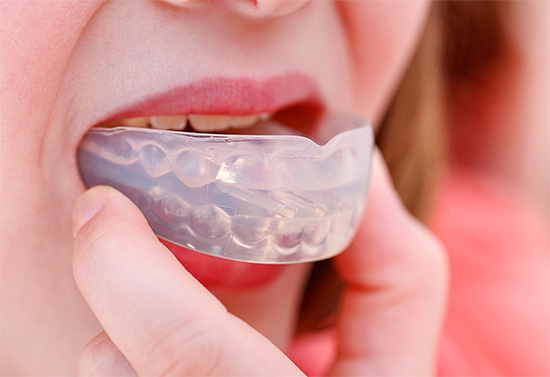
On a note
An orthodontist can recommend myogymnastics - this is a set of physiotherapy exercises to ensure the coordinated work of certain muscles.The complex can be prescribed as a separate treatment option, or with the goal of preventing the formation of malocclusion. Myogymnastics requires discipline and interest from the child, as well as visiting a doctor to monitor the exercise every two weeks, so not all orthodontists use this method in their daily practice, although it is very effective.
The use of the bracket system in the treatment of malocclusion is the method of choice (including in adulthood). What is a bracket system? In simple terms, braces are fixed devices fixed to the teeth, with locks, in which a special program for moving teeth is embedded. The movement is carried out due to the arc, which is fixed in these locks, the arc moves and reaches the ideal shape of the dental arch.
The average treatment time for braces is 1.5-2 years.

Today there are many modifications of bracket systems. For instance:
- ligated braces, that is, the arc is tied to the bracket using special metal or rubber ligatures. Ligatures provide rigid adhesion of the arch to the bracket and limit sliding along the dental arch. The disadvantage of this equipment is the need for frequent visits to the doctor once a month (and some doctors prescribe patients every two weeks). Visits are necessary to replace ligatures, because they tend to weaken.
- Self-ligating bracket systems differ from the previous ones in that the bracket design has a lid that holds the arc inside the lock. This provides a freer glide of the metal arch along the dentition, which is more comfortable for the patient, reduces the number of visits to the doctor and the treatment time. But such braces are more expensive than ligature systems.
Also, bracket systems differ in the material from which they are made:
- The simplest and most noticeable are metal braces. Their plus is that they are very durable. If the bracket comes off, then it can be glued again. Practice shows that metal braces guarantee a reduction in the treatment time for an abnormal bite.

- Plastic braces are more aesthetic, as they coincide with the natural color of the teeth. Of the minuses - they are painted with food and not as durable as metal, which sometimes forces the doctor to glue a new bracket due to the failure of the original, and this is an additional cost for the patient.

- Ceramic braces - not visible on the teeth, more durable than plastic ones. Of the minuses - due to the high degree of friction of the arc in the castle, the total treatment time increases. The cost of such braces is higher than metal and plastic.

- Sapphire braces are as transparent and invisible on the teeth as possible, but much more expensive than analogues.

- Lingual braces - this type of braces is fixed by the doctor on the lingual side of the teeth. Thus, they are not visible to others. However, when wearing such braces, certain difficulties arise: constant irritation of the tongue, impaired diction. Lingual braces require more thorough care and hygiene than with conventional braces. The doctor orders the entire set individually for each patient and, accordingly, if the bracket or arch breaks, then there will be difficulties with repairing and replacing, since arcs and brackets from other systems will not work in this case. The cost of treatment with lingual braces is much higher than on conventional systems.

On a note
It is important to maintain a good level of hygiene when treating braces, brush your teeth after each meal, and use brush sets to clean the area around the bracket, between the arch and the teeth, in addition to the brush. If you neglect hygiene, then the formation of white spots on the teeth is possible - foci of demineralization of enamel in place of the braces, such spots themselves do not pass in the future and require treatment.
Methods for the prevention of malocclusion
It is well known that it is always better to prevent the development of a disease than to treat its consequences.
To prevent the development of malocclusion, the bad habits of the child should be adjusted. For example, in time to excommunicate the baby from the nipple. If you can’t influence the child on your own, then you can buy a special set of devices for the prevention of malocclusion corresponding to the age of the child (for this it is better to consult a doctor so that you can find the right equipment).
Among the set of devices for preventing the formation of malocclusion, for example, the following can be distinguished:
- Kerbitz's vestibular plate - it is similar to the nipple, adheres to the vestibular surface of the teeth, thereby weaning the child from the harmful habit of sucking fingers, nipple, lips, laying the tongue between the teeth, etc.
- Kraus vestibular plate - indicated in the presence of a bad habit of sucking the tongue and impaired swallowing function.
- Müleman propulsor - this device prevents oral breathing, is indicated for the treatment and prevention of distal occlusion and open bite, holds the jaw in the extended position and separates the chewing teeth.

There are other types of devices for the prevention of malocclusion, and for each type of occlusion.
Monitoring the health of the child requires the connection of both dentists and general practitioners to monitor the proper development of all organs and systems. Regular visits to the pediatrician, therapist, otolaryngologist, and speech therapist will help you notice the problems of the dentition in time.
Of course, orthodontic treatment is usually not carried out according to vital indications, but depends only on a person’s desire to improve their appearance (or the appearance of the child). But do not forget about such an important factor as the child’s psycho-emotional state with an abnormal bite: even if there is a seemingly slight flaw, the child already feels different than everyone else, often he becomes depressed and closed. In turn, this is reflected in his communication with others and self-esteem, which often leaves its mark on his whole future life.
Whatever treatment method you choose, a lot depends on the mood of you and your child for long-term treatment in compliance with the specific recommendations of the device wearing regimen, as well as on your trust in the doctor and coordination of your actions with him.
Be healthy and attentive to the health of your children!
An interesting video about the classification of malocclusion and methods of treatment in relevant situations
An orthodontist dentist talks about the important nuances of correcting a malocclusion




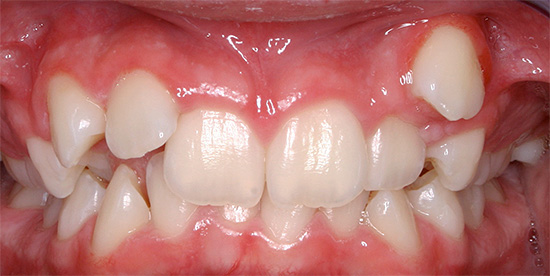


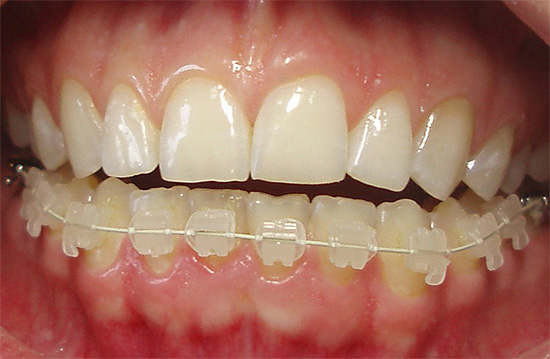




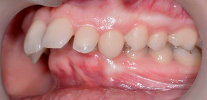
Hello. Daughters 14 years old, put braces. The first day, or rather night, the teeth were very painful. The next day, it was also terribly painful, my daughter called from school and complained, took analgin, did not help. I drank nurofen at night. It has become much easier. Tell me, how long do my teeth hurt after installing braces? I hope not all the time? The doctor said that they should not be very sick ... But here we are.
Hello, Tatyana. After installing braces, patients do sometimes experience pain for 3-5 days. Then the pain subsides. If this does not happen, I recommend that you consult your doctor for advice.
Set braces to align the bite. Then they took off. At first, everything was normal after removal, but then the tooth enamel began to crumble. I also smoke quite a lot. Is it worth it to install implants instead of problem teeth and what is the risk that they will not take root?
Hello, Sergey. If your problem is tooth enamel only, then this is not a direct indication for tooth extraction and implant placement. It is necessary to consult a dentist and treat teeth whose enamel is damaged.
As for implant survival, provided that a competent approach to the choice of implant system and the appropriate doctor qualifications is available, a positive treatment result is achieved in almost 100% of cases, even if the patient is a heavy smoker.